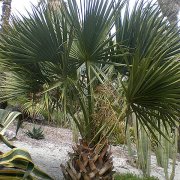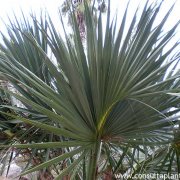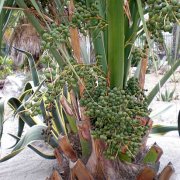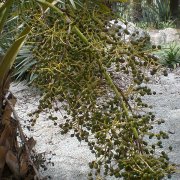Care of the palm tree Sabal bermudana or Bermuda palmetto |
|
The genus Sabal, family Arecaceae, comprises about 15 species of palm trees native to the region between the southern United States and northern South America. Some species are: Sabal bermudana, Sabal uresana, Sabal palmetto, Sabal mexicana, Sabal minor. Common names: Bermuda palmetto, Bermuda cabbage palm, Bibby-tree. This species is native to Bermuda. They are robust, slow-growing palms that reach 30 meters (98.4 feet) in height. The long leaves (up to 2 meters/6.56 feet long) are fan-shaped and have up to 60 leaflets 75 cm (2.46 feet) long; they do not have spines on the petiole. The flowers appear in long inflorescences (up to 2.5 meters/8.2 feet in length) and are yellowish-white. The fruits are small drupes 1 cm (0.39") in diameter and black or dark brown in color. Bermuda palmetto is used as isolated specimens, in small groups and in public parks. It's ideal for Mediterranean coastal gardens. Sabal bermudana needs full sun exposure and a warm climate. It resists frosts down to -10 ºC (14 ºF). Bermuda cabbage palm grows in any well-drained soil but prefers that they have some ability to retain moisture. Water regularly waiting for the substrate to dry. Bibby-tree resists drought well. Bermuda palmetto does not need fertilizer or pruning. Sabal bermudana is a plant resistant to the usual pests and diseases. Bermuda cabbage palm is propagated from seed sown in spring but it is a slow process. |
Images of the palm tree Sabal bermudana or Bermuda palmetto |
Find plants
Sabal bermudana or Bermuda palmetto | Care and Growing
© 2026 FavThemes



